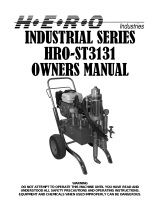
Service
18 308069P
5. Install the grommets (32) in the valve actuator (35).
Install the trip rod (54) in the piston (59). Place the
trip rod yoke (28) and valve actuator (35) on the trip
rod. Be sure the o-ring (36) is in place and that the
valve actuator is supported by the spring clips (58),
and then reassemble the valve mechanism. (FIG.
16)
6. Install the bottom adjusting nuts (33) on the valve
stems (45) and screw the stems into the grommets
(32). Screw the top nuts (33) on the stems. Tighten
the nuts (33) just enough to slightly compress the
grommet (32). Before installing the lockwires (34) in
the adjusting nuts, use the special gauge, Part No.
171818, to adjust the transfer valve so there is 0.145
in. (3.7 mm) clearance between the poppets (52)
and the seat when it is open. (FIG. 17)
7. Install the springs (31) and pivot pins (30) on the
toggle arms (37). Snap the toggles to the up posi-
tion. (FIG. 16)
8. Carefully lower the cylinder (51) over the piston (59)
and onto the base (55). Secure with the six screws
(25).
9. Manually push on the piston rod (41) to move the
piston (59) up as far as it will go. Grip the trip rod
(54) with padded pliers and screw the cylinder cap
nut (47) onto the trip rod. Pull the piston rod (41) to
move the piston downward. Be sure the o-ring (27)
is in place at the top of the cylinder (51), and then
screw the cap nut into the cylinder.
10. Screw the connecting rod (10) into the piston rod
(41) and secure with the pin (4). Screw the riser
tube (12) into the base (55).
11. Install the muffler plates (20, 40). Tighten the throat
packing nut (42) just until snug.
12. Connect an air hose and run the pump slowly (about
30 psi [0.24 MPa, 2.4 bar]) to see that it operates
smoothly.
13. Remount the pump and reconnect the ground wire.
Displacement Pump
Disassembly
Before starting have all necessary parts on hand.
Always replace the glands and bearing when replacing
the packings. Use all the parts in the repair kits for the
best results.
1. Flush the pump and relieve the pressure. See Pres-
sure Relief Procedure, page 8.
2. Disconnect the hoses, remove the pump from its
mounting, and clamp the air motor base in a vise.
3. Unscrew the intake valve body (22) from the riser
tube (12). (FIG. 18)
4. Disassemble the intake valve.
5. Clean and inspect the parts for wear or damage,
and replace parts as needed. Unless further service
is needed, reassemble and reinstall the intake
valves, using liquid sealant on the male threads.
(FIG. 18)
6. Use a strap wrench on the riser tube (12) to screw it
out of the air motor base (55). Carefully inspect the
smooth inner surface of the cylinder for scoring or
irregular surfaces. Such damage causes premature
packing wear and leaking. Replace part if damaged.
7. Unscrew the piston body (13) from the piston cou-
pling (14). Remove the ball (2), seat (19), gasket (6),
bearing (18), packing (17), and seal (16). Do not
remove the press-fit brass bearing (15). (FIG. 18)
NOTE: If the pressure-fit brass bearing (15) needs to be
replaced, clamp it in a vise and drive the piston body
(13) out with a plastic hammer. The new bearing must
be started onto the piston body squarely.




















